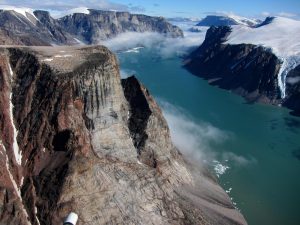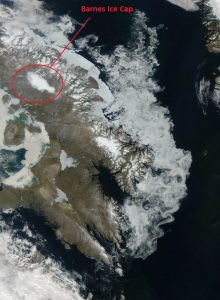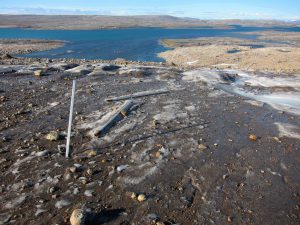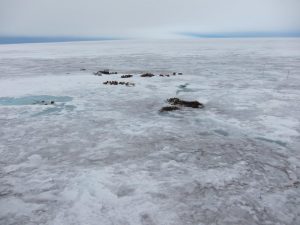Study finds current Arctic warming is almost unheard of in past 2.5 million years
20 March 2017

The scenery at the coast just northeast of the Barnes Ice Cap, the last remnant of the Laurentide Ice Sheet. A new study finds the Barnes Ice Cap is doomed to vanish in the next few centuries.
Credit: Gifford Miller.
WASHINGTON, DC — The last remaining piece of the vast ice sheet that once covered North America is doomed to vanish in the next few centuries, a new study finds.
Rising temperatures in the Arctic have caused the Barnes Ice Cap to melt at an extraordinary pace, and nothing short of removing carbon dioxide from the atmosphere can prevent it from completely disappearing, according to a new study modeling the ice cap’s behavior.
Under a business-as-usual greenhouse gas emissions scenario, the study’s authors project the ice cap will disappear within the next 300 years. For even the most conservative greenhouse gas trajectories where emissions decline substantially after 2020, the ice cap will still disappear in less than 500 years, according to the study.
The results provide compelling evidence that the current level of warming is almost unheard of in the past 2.5 million years, according to the study’s authors.
“This is the disappearance of a feature from the last glacial age, which would have probably survived without anthropogenic greenhouse gas emissions,” said Adrien Gilbert, a glaciologist at Simon Fraser University in British Columbia, Canada, and lead author of the new study published in Geophysical Research Letters, a journal of the American Geophysical Union.
Melting of the Barnes Ice Cap would likely have negligible impacts on sea level rise or the environment, but its end could herald the dissolution of larger ice sheets, according to the study’s authors.
“The fact that it’s disappearing is a minor scientific curiosity,” said Gifford Miller, a glacial geologist at the University of Colorado Boulder and co-author of the new study. “But its disappearance carries information about the really big ice caps. Given enough time on the path we’re currently following, then large portions of the Greenland Ice Sheet may also be at risk of disappearing, and that’s a big deal.”

A map of the Barnes Ice Cap resting on Baffin Island, Canada.
Credit: Jeff Schmaltz/NASA Earth Observatory.
Melting at a not-so-glacial pace
The Laurentide Ice Sheet covered millions of square miles of North America episodically since the start of the Quaternary Period roughly 2.5 million years ago. The ice sheet grew and shrank over time as Earth went through various climate cycles, but started retreating around 14,000 years ago when Earth’s climate warmed considerably. The receding ice stabilized about 2,000 years ago as the Barnes Ice Cap, a Delaware-sized chunk of ice on Baffin Island in the Canadian Arctic.
The Barnes Ice Cap remained the same size for the past 2,000 years until the effects of recent warming caught up with it.
Miller was doing research on Baffin Island in 2009 when he realized the ice cap had noticeably shrunk compared to images of it from a few decades ago. He then recruited Adrien Gilbert and Gwenn Flowers from Simon Fraser University to develop a model for determining how the ice cap might behave in the future.

Glaciologist Roger Hooke drilled a hole into the Barnes Ice Cap in 1978 and cased it with pipes to measure internal strain in the ice cap. When he finished, the pipes stuck out above the ice by about 0.5 m (1.5 feet). When Miller visited the ice cap in July 2010, at least 32 m (100 feet) of pipe lay on the ground (broken, as shown here). That would equate to an average of about 1 meter (3 feet) of ice lost per year.
Credit: Gifford Miller.
In the new study, the researchers used the model to estimate when the ice cap would disappear under different greenhouse gas emissions scenarios. They found the ice cap is melting at all elevations and they project it to be gone within 200-500 years under all future emissions scenarios.
The researchers also collected rock samples around the ice cap to determine whether it had shrunk to a similar size at other times during its history.
They found it to be extremely rare for the Barnes Ice Cap to completely disappear, even during warm interglacial periods. The rock samples showed the ice cap shrunk to its current size only three times and disappeared no more than twice in the past 2.5 million years.
What’s most unusual about the ice cap’s situation is that it is now melting when the summer sun is weakest: Earth is currently as far from the sun as it can get during the Northern Hemisphere’s summer, Miller said.

This image shows Sagar Camp, the very summit of the Barnes Ice Cap and the remains of a glaciological camp occupied in 1963 that was hurriedly abandoned. The camp has been buried by snow ever since and never seen before now. That it has just melted out is confirmed by the poles still vertically in place in the ice.
Credit: Gifford Miller.
“The geological data is pretty clear that [the Barnes Ice Cap] almost never disappears in the interglacial times,” he said. “The fact that it’s disappearing now says we’re really outside of what we’ve experienced in a two-and-a-half million-year interval and we’re entering a new climate state.”
The new study is yet another demonstration that humans are pushing the Earth system outside of conditions that have existed over the last million years, said Richard Alley, a glaciologist and climate scientist at Pennsylvania State University in State College, Pennsylvania, who was not connected to the study.
“We have very high scientific confidence that almost all the glaciers on Earth are shrinking, because of warming that is primarily being caused by our greenhouse gases,” he said.
###
The American Geophysical Union is dedicated to advancing the Earth and space sciences for the benefit of humanity through its scholarly publications, conferences, and outreach programs. AGU is a not-for-profit, professional, scientific organization representing 60,000 members in 137 countries. Join the conversation on Facebook, Twitter, YouTube, and our other social media channels.
Notes for Journalists
This research article is open access for 30 days. A PDF copy of the article can be downloaded at the following link: http://onlinelibrary.wiley.com/doi/10.1002/2016GL072394/pdf.
After 30 days, journalists and public information officers (PIOs) of educational and scientific institutions who have registered with AGU can download a PDF copy of the article from the same link.
Journalists and PIOs may also order a copy of the final paper by emailing a request to Lauren Lipuma at [email protected]. Please provide your name, the name of your publication, and your phone number.
Neither the paper nor this press release is under embargo.
“The projected demise of Barnes Ice Cap: Evidence of an unusually warm 21st century Arctic”
Authors:
Adrien Gilbert, Gwenn E. Flowers: Department of Earth Sciences, Simon Fraser University, Burnaby, British Columbia, Canada;
Gifford H. Miller, Kurt Refsnider: INSTAAR and Department of Geological Sciences, University of Colorado, Boulder, Colorado, U.S.A.;
Nicolás E. Young: Lamont-Doherty Earth Observatory of Columbia University, Palisades, New York, U.S.A.;
Valentina Radić: Department of Earth, Ocean and Atmospheric Sciences, University of British Columbia, Vancouver, British Columbia, Canada.
Contact information for the authors:
Gifford H. Miller: [email protected], +1 (303) 492-6962 (office), +1 (303) 999-5992 (cell).
Lauren Lipuma
+1 (202) 777-7396
[email protected]
University of Colorado Boulder Contact:
Jim Scott
+1 (303) 492-3114
[email protected]